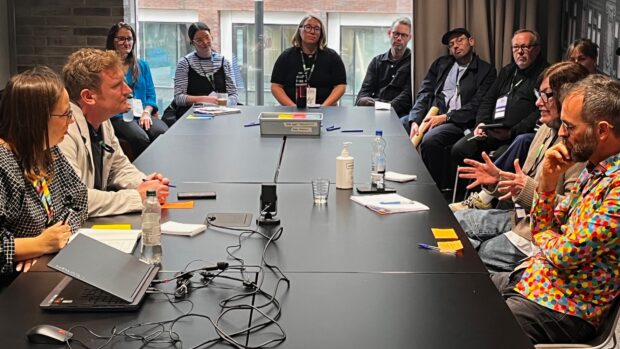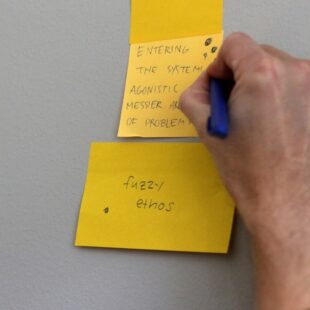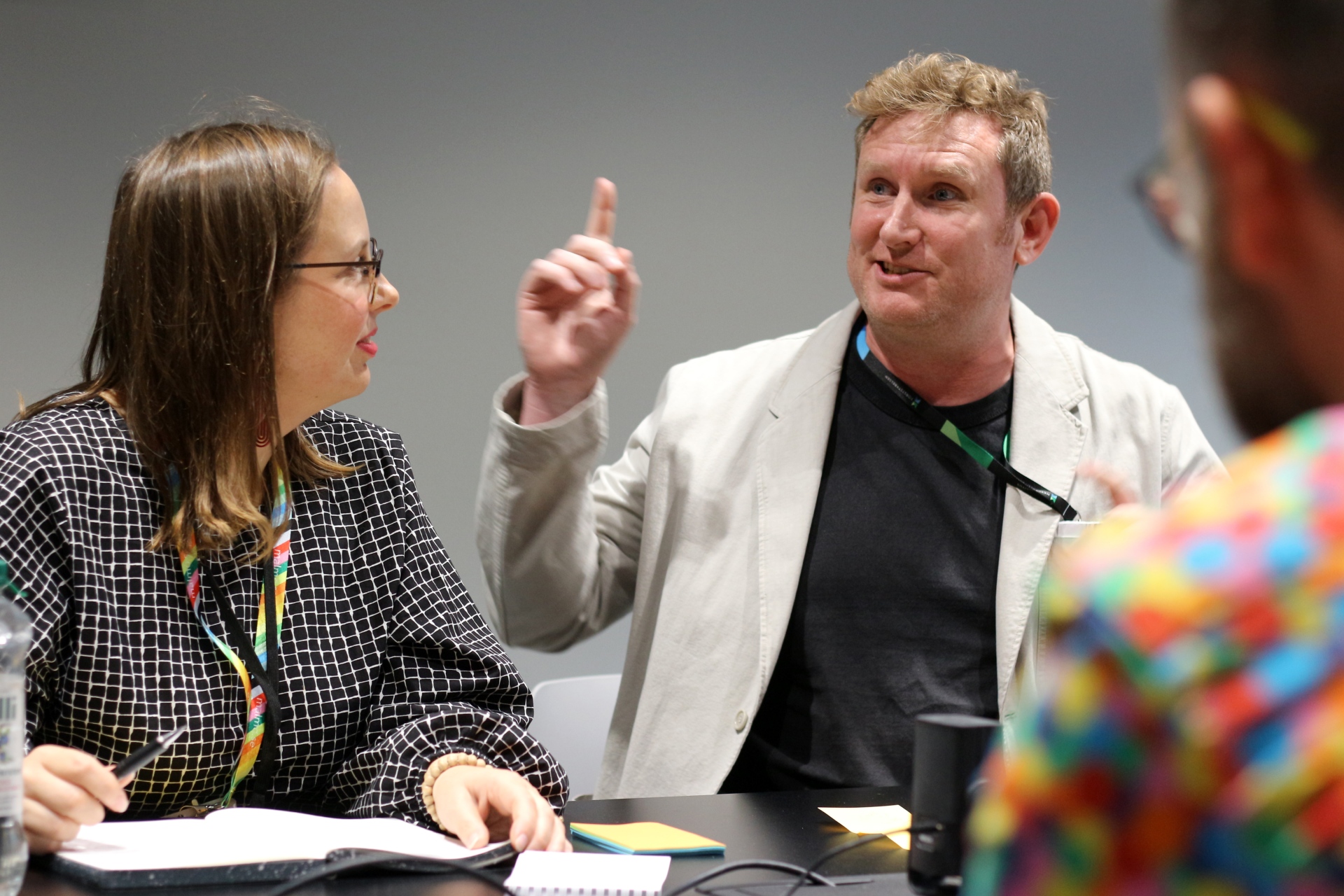Design has taken a spectacular leap forward in the past decade. Service and policy design is changing how public administrations create value for citizens. But if designers are going to continue to mature through their teenage years, then they need to create the enabling conditions right now that will enable designers in 10-years’ time.
Imagining the future of government design
Over 230 designers from 30 nations met in Helsinki in October 2024 to learn from each other. The event was hosted by the Finnish Design Community as part of International Design in Government. During the event over 20 designers from across the planet gathered to discuss what action we could take now to enable designers in the future. The designers made 3 recommendations to governments everywhere. Below is the flow of the discussion…

Conversation in the fishbowl
The discussion was hosted by UK Head of Policy Design, Andrew Knight, using a ‘fishbowl’ format. Andrew was joined by 3 influential design leaders: Anni Leppanen (ex City of Helsinki), Josep Maria Flores Juanpere (Government of Catalonia), and Susan Cullen (Australian Tax Office). Each of the leaders provided a short provocative statement, and then the conversation flowed. The speakers gradually left their seats, making space for individual members of the audience (those outside the fishbowl, looking-in) to take 1 of the 4 hot seats to continue the discussion. Around 20 designers participated. At the end of the discussion, the original 4 speakers made recommendations based on what they had heard, and then the audience voted for their favourites. Brilliant contributions came from Janne Mattila (Kela, Finland), Mirko Wittka (designer, Finland), Shoji Ohashi (Digital Agency, Japan), Andreas Jensen (City of Malmo, Sweden), Julene Aguirre (Ministry of Justice, UK), Ramia Maze (University of Arts London, UK), Becky Miller (Defra, UK), Fiona MacLellan, (Scottish Government), Martin Jordan (Digital Service, Germany), Joshua Pacheco (Digital Service, Germany), Kari-Hans Kommonen (Aalto University, Finland), Jett Pisate Virangkabutra, (Thammasat University, Thailand), Eevi Saarikoski (Verohallinto, Finland), plus many more designers.
Design must be usable by everyone
Designers should not gate-keep the practice of design. Design is ubiquitous; it is already everyone’s job in government to make and improve things – whether that is as grand as developing a flagship tax regime or as humble as improving how post is delivered around the office – these are all designs.
Designers should permit, welcome and encourage others to design. The well of design is deep, and the more that other people are able to practice design at an amateur level, the more demand it generates for design at a professional level (it reminds us of Maya Angelou’s view, “You can’t use up creativity. The more you use, the more you have”).
Taking others in government on a design journey – giving them glimpses of what design can do – generates interest in what can often be an alien way of working for many officials. This also serves to diffuse design skills and values, and helps designers to overcome cultural differences that can act as barriers to design practice.
Design needs to be normalised in governments. If design is not the ‘normal’ way of doing government, then it is far more likely that designers’ designs will get shelved. In the words of Sabine Junginger from Northumbria University, design should be weaved throughout government organisations.

Designers must have a core of professionalism
Of course, being a ‘Swiss army knife’ (having a reputation for being able to fix anything) is a great entry point to government. People see design as being helpful. But it cannot be cast as simply a support role to other professions.
There is a need for professional expert designers. Some design problems are too big or difficult for amateurs to fix. This is where professional designers can serve an important function.
Designers need to be intentional about the work they do in governments to demonstrate their value.
Career pathways will enable designers and the practice to continue elevating. A central core of universal design capabilities that can be deployed by all designers will provide: consistency across the practice; scalability within governments; the nurturing of emerging pockets of design; articulation of the value of design to others like public leaders and ministries of finance; the opportunity to take a seat at the table with governments’ other more-established professions. Codified capabilities make it easier for designers to move around the public sector and easier for governments to hire designers, and yet also provide designers with more job security.
In addition, governments should support designers to have specialisms. Some types of designer have particular capability needs based on the part of the policy-to-delivery pipeline they work in (for example, policy designers need more capability in design futures).
Governments are looking for new holistic ways to measure value beyond the traditional accountancy approach to understanding financial efficiency. There are two alternative ways to measure the holistic value of design, by examining outputs and process. Outputs can be measured in a more holistic way by simply aiming to deliver a broader set of things like the UN’s Sustainable Development Goals. But we can also measure the process of designing – in other words, the design effort that is put into making policies and services. This offers ministries of finance a new tool for understanding the costs and benefits of delivering financial and wellbeing value to citizens – and also makes it explicit how important design is for delivering public value. But for us to realise this future understanding of value through the process of design, we must codify what design is and how it operates – importantly, we need to be clear on what the common practices of designers are.
Alongside this, designers need ‘pockets of reflection’ and to pass knowledge between generations of designers for design practice to grow. Designers should think about their shared ethos and question what it means to design. This identity already holds designers together as a community and will hold them together as a profession.
Designers must have fuzzy edges
 The edges of designers’ capability must remain porous and fuzzy. Designers have a unique role in synthesising and responding to interdisciplinary evidence bases (the ‘outside-in’ approach). This will continue to become more challenging as the complexity of the systems and problems that designers seek to solve increase.
The edges of designers’ capability must remain porous and fuzzy. Designers have a unique role in synthesising and responding to interdisciplinary evidence bases (the ‘outside-in’ approach). This will continue to become more challenging as the complexity of the systems and problems that designers seek to solve increase.
So designers must be able to look backwards to better understand the ‘archaeology of designs’ (there is very little ‘greenfield’ design in the public sector, so we must understand how and why existing designs were produced by governments (by designers or not) and how they have evolved). And designers must look forwards by continuing to stretch their capability for understanding the world through the lens of other experts, and developing new methods for synthesis and response.
Public design should keep the spirit of being ‘undefined’ and ‘messy’ to stay responsive and to foster emergence, so that designers — and everyone deploying design practice across the public sector— can be at the forefront of tackling systems-level challenges over the next 10 years.
Join our Community
We use this blog to talk about the work of the multidisciplinary policy design community. We share stories about our work, the thinking behind it and what policymaking might look like in the future. If you would like to read more, then please subscribe to this blog. If you work for the UK’s government, then you can you join the policy design community. If you don’t work for the UK government, then connect with us on social media at Design and Policy Network and subscribe here to be notified about our monthly speaker events to hear from influential design thought leaders and practitioners.











